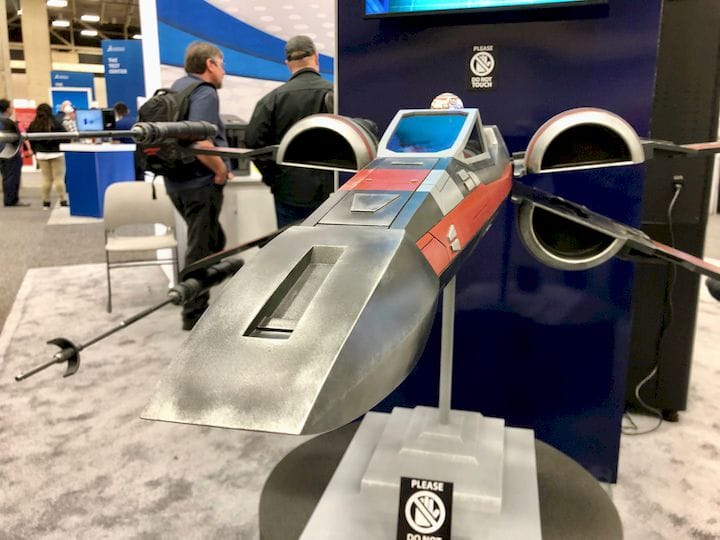![A huge 3D printed Star Wars X-Wing Fighter [Source: Fabbaloo]](https://fabbaloo.com/wp-content/uploads/2020/05/image-asset_img_5eb09c26560bb.jpg)
This week’s selection is the Giant X-Wing by artist Stefan Ulrich of RandomDesign.
Ulrich, based in Michigan, built a massive 3D print of the famous Star Wars X-Wing fighter, literally from scratch.
No, this was not printed from a given 3D model; Ulrich had to model the fighter himself, which apparently took over three months to complete. Once the modeling was completed, the enormous task of 3D printing was next.
![The Star Wars X-Wing Fighter 3D model was split into 152 printable parts [Source: Stefan Ulrich]](https://fabbaloo.com/wp-content/uploads/2020/05/image-asset_img_5eb09c26b0bbf.jpg)
Here’s the amazing part: he printed the entire thing on a modest Sindoh 3DWox desktop 3D printer. This well-regarded device doesn’t offer a particularly large build volume, so Ulrich was forced to split the model into an astonishing 152 parts.
Printing 152 large parts on a single small desktop 3D printer would clearly take much time, and that’s exactly what happened here. Ulrich tried to minimize the print time by cutting the parts in such a way as to require minimal or no support structures, for example. However, parts were mostly 3D printed with 0.2mm layers and 25% infill.
![The BB8 riding the huge 3D printed X-Wing Fighter [Source: Fabbaloo]](https://fabbaloo.com/wp-content/uploads/2020/05/image-asset_img_5eb09c26ed86b.jpg)
The BB8 component, however, was printed with 0.1mm layers because of the detail required on that part.
In spite of printing speedups, it still required two months of continuous “daytime” 3D printing to get all 152 parts printed. The turbine alone took 56 hours to complete.
![Sanding parts of the 3D printed X-Wing Fighter [Source: Stefan Ulrich]](https://fabbaloo.com/wp-content/uploads/2020/05/image-asset_img_5eb09c273da83.jpg)
But once printed, that was certainly not the end of the work. Ulrich had to sand all the parts, assemble them together and fill gaps with body putty. And more sanding.
![Filling gaps when assembling the 3D printed X-Wing fighter [Source: Stefan Ulrich]](https://fabbaloo.com/wp-content/uploads/2020/05/image-asset_img_5eb09c2788da4.jpg)
The X-Wing Fighter includes lighting. Ulrich had to install wiring, power and LED lights at certain points in the design.
![The friction fit design of the parts for the 3D printed X-Wing Fighter [Source: Fabbaloo]](https://fabbaloo.com/wp-content/uploads/2020/05/image-asset_img_5eb09c27e387e.jpg)
One interesting aspect of the X-Wing Fighter’s design is that the parts are not glued together. They were carefully designed to friction fit each other. This allows Ulrich to easily disassemble the X-Wing Fighter in only moments for easy transport to another location. This is important, because the otherwise quite spindly design of the fighter would be quite troublesome to move around.
![Painting components for the 3D printed X-Wing Fighter [Source: Stefan Ulrich]](https://fabbaloo.com/wp-content/uploads/2020/05/image-asset_img_5eb09c2838392.jpg)
Finally, painting. Ulrich told us he used acrylic paint issued through a paint gun for most of the parts. As you can see, several different paint colors were required to complete the work.
This model is inspiring because it shows what is possible even on the smallest of 3D printers. You can make huge, majestic prints if you are sufficiently determined and have the time to complete the work.
In “real life”, Ulrich designs and builds custom computer cases, often to accommodate different parts. He often uses 3D printing to build parts for these cases, and that’s how he gained the knowledge to be able to build the X-Wing Fighter.
![Another view of the 3D printed X-Wing Fighter [Source: Fabbaloo]](https://fabbaloo.com/wp-content/uploads/2020/05/image-asset_img_5eb09c2888bd9.jpg)
But why build this model at all? Ulrich said:
“Because I could.”











This week’s selection is a 3D printed Coronavirus!